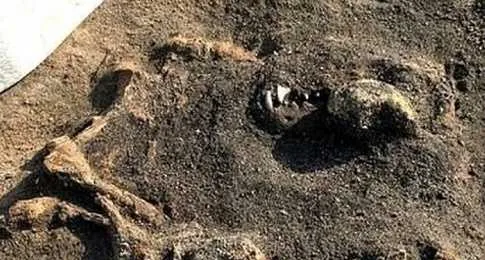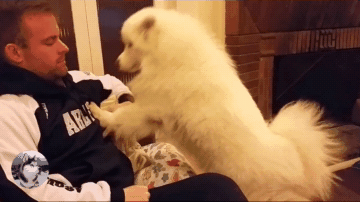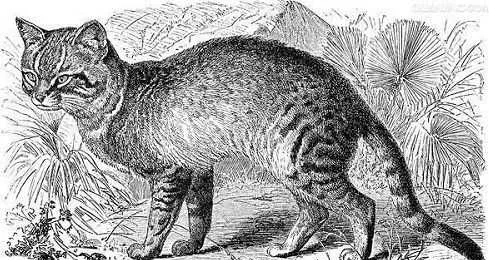犬与猫:从冰河时代走来的末世战友vs主动选择蹭吃蹭喝的佛系室友
在最后一次冰河时代(末次冰盛期LGM)即将结束的某个时候,西伯利亚东北部的草原上一群已然长出铲型门齿的人类手持石器追逐着长毛象,这只离群的大家伙惊恐地发现,自己的前方数只似狼非狼的生物早已锁死了它的去路。

是的, 早在23000年前,被完全驯化的狗狗便与人类结伴而行 [1] [2] : 巡视、狩猎、与人类并肩而战。 在那四分之一的世界被冰雪覆盖的土地上,它们的足迹也伴随人类向全世界扩散,有的留在欧亚大陆、有的伴随主人一路漂洋过海到了美洲 [3] ,一万年后,全世界都有了它们的踪迹 [4] ——末次冰盛期限制了人口的增长,但并不阻碍人类与犬只进一步加深友谊—— 在那个低温少雨的时代 [5] ,与犬类共谋生计的记忆可以说是刻进了我们的「骨子」里。
(狗与狼确切分化约在20000-45000年前 [4] [6] ,狗可能起源于一个已灭绝的狼谱系)
在跟随人类迁徙的同时,狗狗也为更适应人类产生了明确的进化: 读懂人类的面部表情并感知他们的情绪 [7] [8] 、把之于人类的兴奋反应在一个单独的脑分区 [9] 、模仿人类的动作与行为 [10] [11] 甚至进化出控制眉眼的肌肉做出更丰富的表情来向人类撒娇 [12] ...

心理学家Mary Ainsworth设计了依恋理论最重要的实验「陌生环境实验」(the Ainsworth Strange Situation) [13] [14] ,有不少学者在狗狗身上也做了这个实验 [15] [16] ,得出的结论是 在与主人别离又重逢后,狗狗的表现类同于相同情况下婴儿之于母亲的行为。狗狗的行为举止和心率等生理指标也与主人紧密关联 [17] [18] 。
人类呢,也与狗狗产生了趋同进化 (Convergent Evolution,即源自不同祖先的生物,由于相似的生活方式,整体或部分形态结构向着同一方向改变),一起变得更加擅长消化淀粉 [19] 。此外,一项研究表明 人与狗相互凝视会导致双方产生类似于母亲与婴儿之间的那种激素反应 [20] 。

显而易见,人与狗狗的纽带跨越了时空与物种。
反观猫咪,大约在一万年前的新石器时代,位于中东新月沃土地带的早期人类首先进入了农业定居时代,最早的谷物贮藏引来了家鼠,吃饱喝足的家鼠又引来了分布于中东的野猫亚种非洲野猫(F.s.lybica)。
随着人类的聚居, 原先偏好独居的野猫们在这个稳固的生态位上演化成了具有一定社会性的家猫, 形成自己稳固的聚居群体 与人类共生 [21] [22] 。简言之,相比被人类通过行为交流和指令诱导进行选择的狗狗,猫咪是主动抱上了人类大腿 [23] [24] , 比起狗与人的从属关系,猫咪更像是人类的室友。

尽管猫咪也进化出了 用喵喵叫这种暴露自己位置的行为取悦与呼唤人类的「语言」系统 [25] ,但 它们与人类的一些互动依然建立在它们乐意且没厌烦的基础上 (比如被抚摸这种「异体理毛行为」 [26] ,愿意给你撸就给,不乐意或者厌烦了吭哧就一口)。

东京大学认知与行为科学学院和日本理化学研究所中心的科学家们在动物行为学期刊ANIMAL COGNITION上一篇文章 [27] ,他们研究了20只猫咪在家时之于自己主人和陌生人呼唤声的反应,研究表明喵星人只会在听到主人叫它们名字时才会抖动耳朵认真倾听,而在陌生人叫它们时表现的无动于衷 (可悲的是,该调查中没有一只猫会在听到主人叫后,起身去寻找主人), 仅仅是向下动几下耳朵,这表示「我在听」。比起一被呼唤就弹射起步的狗狗,猫咪显然没用那么热情╮(╯▽╰)╭

当然,猫咪的性格分化比狗狗要大,生活中也不乏毛毛的粘人精~
试图安慰自己点说,我家猫依然会每天蹲在门前,等待它唯一的、可以信赖的大英雄狩猎归来。

末世主题的电影,往往充斥着着 物资匮乏、环境恶化、文明倒退、人类互相攻击 等元素, 在一片危机四伏的土地上,一只更默契、忠诚且拥有一定扑咬与携行能力的狗狗,自然还是要比猫咪靠谱许多,对吧?

对不起拿错图了Σ( ⚆൧⚆)

知乎日报收录、官方微博推荐的零基础养狗攻略:
日报专题双收录的手把手教你养猫工具文:
参考
- ^ Larson G , Bradley D G , Andersson L . How Much Is That in Dog Years? The Advent of Canine Population Genomics[J]. PLOS Genetics, 2014, 10(1):e1004093-.
- ^ Larson G , Bradley D G , Andersson L . How Much Is That in Dog Years? The Advent of Canine Population Genomics[J]. PLOS Genetics, 2014, 10(1):e1004093-.
- ^ Perri A R , Feuerborn T R , Frantz L , et al. Dog domestication and the dual dispersal of people and dogs into the Americas[J]. Proceedings of the National Academy of Sciences, 2021, 118(6).
- ^ a b Pavlidis P & Somel M., Science DOI: 10.1126/science.abe7823 (2020).
- ^ 叶佰生, 李世杰. 从末次冰盛期冰川规模探讨当时的气候环境[J]. 冰川冻土, 1997.
- ^ Laura R. Botigué, Song S , Scheu A , et al. Ancient European dog genomes reveal continuity since the Early Neolithic[J]. Nature Communications, 2017, 8:16082.
- ^ Custance D , Mayer J . Empathic-like responding by domestic dogs (Canis familiaris) to distress in humans: An exploratory study[J]. Animal Cognition, 2012, 15(5):851.
- ^ Natalia, Albuquerque, Kun, et al. Dogs recognize dog and human emotions[J]. Biology Letters, 2016, 12(1):20150883-20150883.
- ^ Shaw A . How dogs love us: A neuroscientist and his dog decode the canine brain. Gregory Berns[J]. Mpra Paper, 2015, 5(1):1-7.
- ^ Merola I , Prato-Previde E , Marshall-Pescini S . Social referencing in dog-owner dyads?[J]. Animal Cognition, 2011, 15(2):175-185.
- ^ Bowlby J . the dog-human bond[J]. Galody Com.
- ^ Kaminski J , Waller B M , D Rui, et al. Evolution of facial muscle anatomy in dogs[J]. Proceedings of the National Academy of Sciences, 2019, 116(29):201820653.
- ^ Ainsworth M , Blehar M C , Waters E , et al. Patterns of Attachment: A Psychological Study of the Strange Situation[J]. Lawrence Erlbaum Associates, 1978, 23.
- ^ Main M , Kaplan N , Cassidy J . Security in Infancy, Childhood, and Adulthood: A Move to the Level of Representation[J]. Monographs of the Society for Research in Child Development, 1985, 50(1/2):66-104.
- ^ Prato-Previde E , Custance D M , Spiezio C , et al. Is the dog-human relationship an attachment bond? An observational study using Ainsworth's strange situation[J]. Behaviour, 2003, 140(2):225-254.
- ^ Topál, József, Miklósi, ádám, Csányi, Vilmos, et al. Attachment Behavior in Dogs (Canis familiaris): A New Application of Ainsworth's (1969) Strange Situation Test[J]. Journal of Comparative Psychology, 1998, 112(3):219-229.
- ^ Palestrini C , Prato-Previde E , Custance D M , et al. Heart rate and behavioural responses of dogs (Canis familiaris) in the Ainsworth's Strange Situation Test: A pilot study. 2001.
- ^ Brubaker, Lauren, Udell, et al. Are Dogs Social Generalists? Canine Social Cognition, Attachment, and the Dog-Human Bond[J]. Current Directions in Psychological Science A Journal of the American Psychological Society, 2016.
- ^ Shannon L M , Boyko R H , Castelhano M , et al. Genetic structure in village dogs reveals a Central Asian domestication origin[J]. Proceedings of the National Academy of Sciences of the United States of America, 2015:13639-44.
- ^ H. Ross, L. J. Young, Oxytocin and the neural mechanisms regulating social cognition and affiliative behavior. Front Neuroendocrino 30, 534–547 (2009).
- ^ CHARLOTTE, CAMERON-BEAUMONT, SARAH, et al. Evidence suggesting preadaptation to domestication throughout the small Felidae[J]. Biological Journal of the Linnean Society, 2002.
- ^ 「The Evolution of House Cats」, Carlos A. Driscoll, Juliet Clutton-Brock,【SCIENTIFIC AMERICAN】, 2009.6
- ^ Cluttonbrock T . SOCIAL-BEHAVIOR IN FLUCTUATING POPULATIONS - COCKBURN,A[J]. NATURE, 1988, 334(6177):24---24.
- ^ Veitch C R . Taylor & Francis Online :: The eradication of feral cats (Felis catus) from Little Barrier Island, New Zealand - New Zealand Journal of Zoology - Volume 28, Issue 1[J]. New Zealand Journal of Zoology.
- ^ McComb K, Taylor AM, Wilson C, Charlton BD (2009) The cry embedded within the purr. Curr Biol 19:R507–R508
- ^ 比较心理学辞典/任仁眉 主编.—上海:上海教育出版社,2005.3
- ^ Saito A , Shinozuka K . Vocal recognition of owners by domestic cats (Felis catus)[J]. Animal Cognition, 2013, 16(4):685-690.










